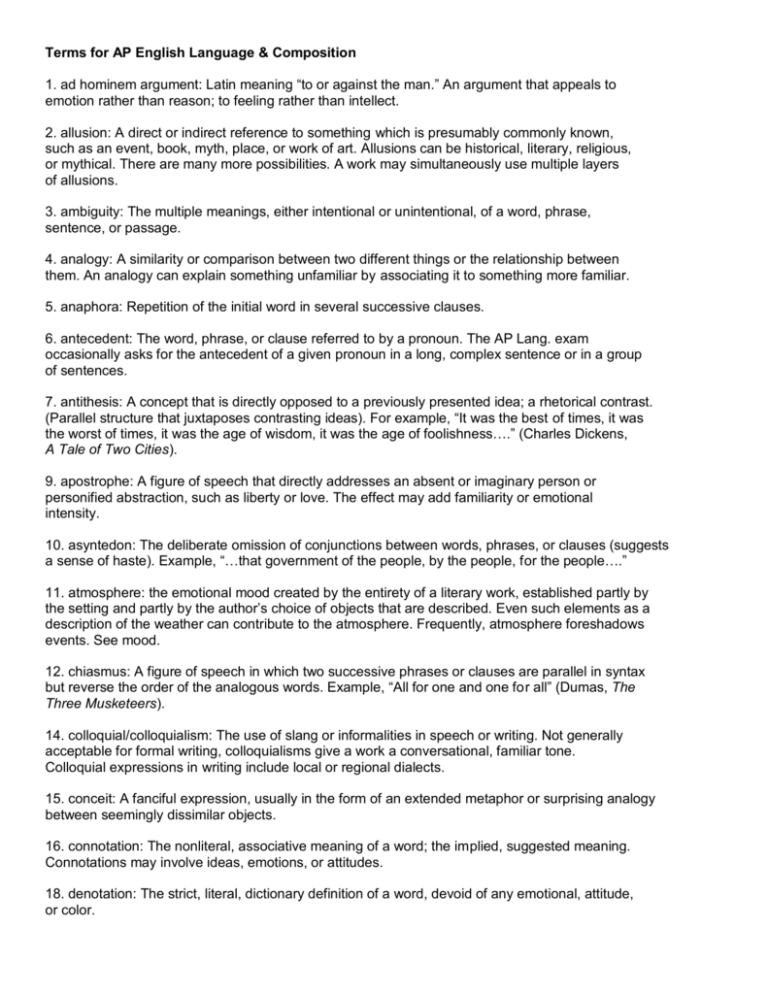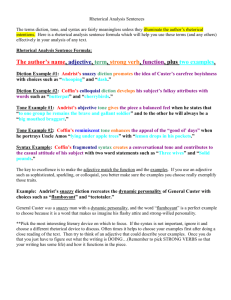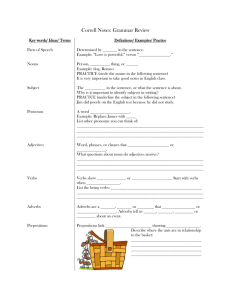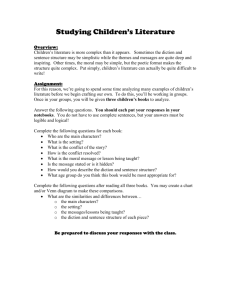Terms for AP English Language & Composition 1. ad hominem
advertisement

Terms for AP English Language & Composition 1. ad hominem argument: Latin meaning “to or against the man.” An argument that appeals to emotion rather than reason; to feeling rather than intellect. 2. allusion: A direct or indirect reference to something which is presumably commonly known, such as an event, book, myth, place, or work of art. Allusions can be historical, literary, religious, or mythical. There are many more possibilities. A work may simultaneously use multiple layers of allusions. 3. ambiguity: The multiple meanings, either intentional or unintentional, of a word, phrase, sentence, or passage. 4. analogy: A similarity or comparison between two different things or the relationship between them. An analogy can explain something unfamiliar by associating it to something more familiar. 5. anaphora: Repetition of the initial word in several successive clauses. 6. antecedent: The word, phrase, or clause referred to by a pronoun. The AP Lang. exam occasionally asks for the antecedent of a given pronoun in a long, complex sentence or in a group of sentences. 7. antithesis: A concept that is directly opposed to a previously presented idea; a rhetorical contrast. (Parallel structure that juxtaposes contrasting ideas). For example, “It was the best of times, it was the worst of times, it was the age of wisdom, it was the age of foolishness….” (Charles Dickens, A Tale of Two Cities). 9. apostrophe: A figure of speech that directly addresses an absent or imaginary person or personified abstraction, such as liberty or love. The effect may add familiarity or emotional intensity. 10. asyntedon: The deliberate omission of conjunctions between words, phrases, or clauses (suggests a sense of haste). Example, “…that government of the people, by the people, for the people….” 11. atmosphere: the emotional mood created by the entirety of a literary work, established partly by the setting and partly by the author’s choice of objects that are described. Even such elements as a description of the weather can contribute to the atmosphere. Frequently, atmosphere foreshadows events. See mood. 12. chiasmus: A figure of speech in which two successive phrases or clauses are parallel in syntax but reverse the order of the analogous words. Example, “All for one and one for all” (Dumas, The Three Musketeers). 14. colloquial/colloquialism: The use of slang or informalities in speech or writing. Not generally acceptable for formal writing, colloquialisms give a work a conversational, familiar tone. Colloquial expressions in writing include local or regional dialects. 15. conceit: A fanciful expression, usually in the form of an extended metaphor or surprising analogy between seemingly dissimilar objects. 16. connotation: The nonliteral, associative meaning of a word; the implied, suggested meaning. Connotations may involve ideas, emotions, or attitudes. 18. denotation: The strict, literal, dictionary definition of a word, devoid of any emotional, attitude, or color. 19. diction: Related to style, diction refers to the writer’s word choices, especially with regard to their correctness, clearness, or effectiveness. For the AP Exam, you should be able to describe an author’s diction (for example, formal, informal, ornate, plain, colloquial, or slang) and understand the ways in which diction can complement the author’s purpose and meaning. Diction, combined with syntax, figurative language, literary devices, imagery, etc., creates an author’s style. (NOTE: This term frequently appears in the essay question’s wording. In your thesis avoid phrases such as, “The author uses diction….” Since diction, by definition, is word choice, this phrase really says, “The author chooses words to write….” which is as redundant as claiming, “A painter uses paints to paint.” Try to put an adjective in front of the word diction to help describe it, such as “stark diction” or “flowery and soft diction.”) 20. didactic: From the Greek, didactic literally means teaching. didactic works have the primary aim of teaching or instructing, especially the teaching of moral or ethical principles. 21. euphemism: From the Greek for “good speech,” euphemisms are a more agreeable or less offensive substitute for generally unpleasant words or concepts. The euphemism may be used to adhere to standards of social or political correctness, or to add humor or ironic understatement. Euphemisms are associated diction. 22. figurative language: Writing or speech that is not indented to carry a literal meaning and is usually meant to be imaginative and vivid. 23. figure of speech: A figure of speech is a device used to produce figurative language. Many compare dissimilar things. Figures of speech include apostrophe, hyperbole, irony, metaphor, metonymy, oxymoron, paradox, personification, simile, synecdoche, and understatement. 24. generic conventions: This term describes traditions for each genre. These conventions help to define each genre; for example, they differentiate between an essay and journalistic writing or an autobiography and political writing. On the AP Exam, try to distinguish the unique features of a writer’s work from those dictated by convention. 25. homily: This term literally means “sermon,” but more informally, it can include any serious talk, speech, or lecture involving moral or spiritual advice. 26. hyperbole: A figure of speech using deliberate exaggeration or overstatement. Hyperboles often have a comic effect; however, a serious effect is also possible. Often, hyperbole produces irony at the same time. 27. imagery: The sensory details or figurative language used to describe, arouse emotion, or represent abstractions. On a physical level, imagery uses terms related to the five senses; we refer to visual, auditory, tactile, gustatory, or olfactory imagery. On a broader and deeper level, however, one image can represent more than one thing. For example, a rose may present visual imagery while also representing the color in a woman’s cheeks. An author, therefore, may use complex imagery while simultaneously employing other figures of speech, especially metaphor and simile. In addition, this term can apply to the total of all the images in a work. On the AP Exam, pay attention to HOW an author creates imagery and to the EFFECT of that imagery. 28. inference/infer: To draw a reasonable conclusion from the information presented. The most direct, most reasonable inference is the safest answer choice. (If the answer choice is directly stated, is not inferred and is wrong.) 29. irony/ironic: The contrast between what is stated explicitly and what is really meant; the difference between what appears to be and what actually is true. The three types of irony are verbal, situational, and dramatic. 30. loose sentence (cumulative): A type of sentence in which the main clause is followed by subordinate clauses or phrases that supply additional detail. A work containing many loose sentences often seems informal, relaxed, and conversational. 31. metonymy: A figure of speech that replaces the name of something with a word or phrase closely associated with it. Similar to synecdoche. Example, the white house instead of the president or brass to mean military officers. 32. mood: This term has two distinct technical meanings in English writing. GRAMMATICAL mood deals with verbal units and a speaker’s attitude, such as indicative, subjective, or imperative moods. LITERARY mood refers to prevailing atmosphere or emotional aura of a work. Setting, tone, and events can affect the mood. 33. parallelism: Also called parallel construction or parallel structure, this term refers to the grammatical or rhetorical framing of words, phrases, sentences, or paragraphs to give structural similarity. Charles Dickens’s novel A Tale of Two Cities begins with an example: “It was the best of times, it was the worst of times, it was the age of wisdom, it was the age of foolishness….” Parallel construction acts as an organizing force to attract the reader’s attention, add emphasis and organization, or simply to provide a musical rhythm. 34. parody: A word that closely imitates the style or content of another with the specific aim of comic effect and/or ridicule. As comedy, parody distorts or exaggerates distinctive features of the original. As ridicule, it mimics the work by repeating and borrowing words, phrases, or characteristics in order to illuminate weaknesses in the original. 35. pathos: The quality of a literary work or passage which appeals to the reader’s or viewer’s emotions – especially pity, compassion, and sympathy. 36. pathetic fallacy: A special type of personification in which inanimate aspects of nature, such as the landscape or the weather, are represented as having human qualities or feelings. Example, “The air was pitilessly raw…” (Joyce, “Araby”). 37. pedantic: An adjective that describes words, phrases, or general tone that is overly scholarly, academic, or bookish. 38. periodic sentence: A sentence that presents its central meaning in a main clause at the end, usually preceded by subordinate clauses or phrases. Example, “Crossing a bare common, in snow puddles, at twilight, under a clouded sky, without having in my thoughts any occurrence of special good fortune, I have enjoyed a perfect exhilaration. 39. polysyndeton: The presence of more conjunctions than normal. Example, “Tomorrow, and tomorrow, and tomorrow creeps in this petty pace from day to day…” (Shakespeare, McBeth). 40. predicate adjectives: One type of subject complement – an adjective, group of adjectives, or adjective clause that follows a linking verb. It is in the predicate of the sentence and modifies or describes the subject. Example, My boyfriend is tall, dark, and handsome. 41. predicate nominative: A second type of subject complement – a noun, group of nouns, or noun clause that renames the subject. It, like the predicate adjective, follows a linking verb and is located in the predicate of the sentence. Example, Abe Lincoln was a man of integrity. 42. rhetoric: From the Greek for orator, this term describes the principles governing the art of writing effectively, eloquently, and persuasively. 43. rhetorical modes: This term describes the variety, the conventions, and the purposes of the major kinds of writing. The four most common are exposition, argument, description, and narration. 44. rhetorical question: A question that is asked merely for effect and does not expect a reply. The answer is assumed. 45. sarcasm: From the Greek meaning to tear flesh, sarcasm involves bitter, caustic language that is meant to hurt or ridicule someone or something. It may use irony as a device, but not all ironic statements are satire, that is, intending to ridicule. When done well, sarcasm can be witty and insightful; when poorly done, it’s simply cruel. 46. satire: A work that targets human vices and follies, or social institutions and conventions, for reform or ridicule. Satire is best seen as a style of writing rather than a purpose for writing. It can be recognized by the many devices used effectively by the satirist such as irony, wit, parody, caricature, hyperbole, understatement, and sarcasm. 47. shift (rhetorical): In writing, a movement from one thought or idea or tone to another; a change. 48. style: the consideration of style has two purposes: 1. An evaluation of the sum of the choices an author makes in blending diction, syntax, figurative language, and other literary devices. We can analyze and describe an author’s personal style and make judgments on how appropriate it is to the author’s purpose. Styles can be called flowery, explicit, succinct, rambling, bombastic, commonplace, incisive, laconic, plain, ornate, complex, etc. 2. Classification of authors to a group and comparison of an author to similar authors. By means of such classification and comparison, one can see how an author’s style reflects and helps to define a historical period, such as the Renaissance or the Victorian period, or a literary movement, such as romantic, transcendental, or realist movement. 49. subject complement: The word (with any accompanying phrases) or clause that follows a linking verb and complements, or completes, the subject of the sentence by either (1) renaming it [predicate noun] or (2) describing it [predicate adjective]. 50. subordinate clause: Like all clauses, this word group contains both a subject and a verb (plus any accompanying phrases or modifers), but unlike the independent (or main) clause, the subordinate clause cannot stand alone; it does not express a complete thought. Also called a dependent clause, it depends on a main clause to complete its meaning. Key words and phrases usually begin these clauses, such as although, because, unless, if, even though, since, as soon as, while, who, when, where, how, that. 51. subordination: The art of placing in, or occupying, a less equal position in a sentence. Think of a subordinate clause used as a noun, adjective, or adverb. Example: John held the dog when Tom opened the door. 52. syllogism: From the Greek for reckoning together, a syllogism (or syllogistic reasoning) is a deductive system of formal logic that presents two premises – the first called “major” and the second “minor” – that inevitable lead to a sound conclusion. For example: Major premise: All men are mortal. Minor premise: Socrates is a man. Conclusion: Therefore, Socrates is mortal. A syllogism’s conclusion is valid only if each of the two premises is valid. Syllogisms may also present the specific idea first (“Socrates”) and the general idea second (“All men”). 53. synecdoche: A figure of speech where one part represents the entire object, or vice versa. Example: All hands on deck. “… lend me your ears.” 54. syntax: The way an author chooses to join words into phrases, clauses, and sentences. Syntax is similar to diction, but you can differentiate the two by thinking of syntax as referring to groups of words, while diction refers to individual words. • In the multiple-choice section of the AP Language Exam, expect to be asked some questions about how an author manipulates syntax. • In the essay section, you will need to analyze how syntax affects an author’s style or meaning. When you analyze syntax, consider such elements as the length or brevity of sentences, unusual sentence constructions, the sentence patterns used, and the kinds of sentences the author uses. The writer may use questions, declarations, exclamations, repetition, or rhetorical questions; sentences are also classified as periodic or loose, simple, compound, complex, or compound-complex. • First try to classify what kind of sentences the author uses. • Then try to determine how the author’s choices amplify meaning; in other words, why they work well for the author’s purpose. 55. tone: Similar to mood, tone describes the author’s attitude toward his or her material, the audience, or both. Considering how a work would sound if it were read aloud can help in identifying an author’s tone. Some words describing tone are playful, serious, businesslike, sarcastic, humorous, formal, acerbic, didactic, etc. As with attitude, an author’s tone in the exam’s passages can rarely be described by one word. Expect that it will be complex. 56. transitions: A word or phrase that links different ideas. Used especially, although not exclusively, in expository and argumentative writing, transitions effectively signal a shift from one idea to another. 57. zeugma: The use of a single word to refer to or to describe two different words in a sentence resulting in two different meanings. Example: “… or stain her honour or her new brocade” (Pope’s Rape of the Lock).






